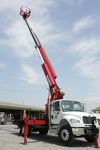Green News
Purchasing fuel-efficient technology may be one of the best options utility fleets have to reduce costs. Now, significant and easily accessible funding is becoming more readily available.
In California, one program that is proving highly beneficial is the Hybrid and Zero-Emission Truck and Bus Voucher Incentive Project (HVIP). Similar programs may also be coming soon to other parts of the country, including New York state and the city of Chicago, among others.
Now in its third year, HVIP is administered and implemented through a partnership between the California Air Resources Board and CALSTART, the clean transportation technology and fuels consortium. To date, more than $28 million has been delivered through the program, and 1,200+ hybrid and electric vehicles have been delivered. Additional funding is available to both public and private utility and telecom companies.
HVIP is designed to offset about half of the additional cost of eligible vehicles, including hybrid, battery-electric, and hydrogen fuel cell vehicles for medium- and heavy-duty trucks and buses. Vouchers range from $8,000 to $55,000 per vehicle depending on the vehicle size and model and the total number of vehicles purchased. Approved voucher amounts are deducted at the time of purchase.
Vehicles that are outfitted with hybrid aerial boom lifts, such as the Altec JEMS, are eligible for funding even if the lifts are installed on a vehicle without a hybrid driveline. Other manufacturers with eligible hybrid vehicles include Freightliner, Freightliner Custom Chassis Corp., Peterbilt, Kenworth, Hino, Altec, Autocar and Thomas Built. Current electric vehicle offerings include Smith Electric, Electric Vehicles International and Boulder Electric.
HVIP is also a fit for school districts and bus companies, and there are several different makes and models of buses currently eligible for the program. In the Kings Canyon Unified School District, which serves students in a 600-square-mile area in California, alternative fuel vehicles were purchased using funds from a variety of sources.
Included were five hybrid-electric school buses built by International Coach using HVIP as a main source of funding combined with funds from the California Air Resources Board (ARB)/San Joaquin Valley Air Pollution Control District Lower-Emission School Bus Program, the Federal Highway Administration Congestion Mitigation and Air Quality Improvement Program or Sacramento Metropolitan Air Quality Management District/U.S. EPA Diesel Emissions Reduction Act, and Fresno County Transportation Authority Measure C funds. The school district also received funding for an ARB AB 118 Air Quality Improvement Program Hybrid/Electric School Bus Demonstration Project to allow neighboring school districts to test the advanced technology buses.
“We continue to seek grant award opportunities that improve our clean air goals and lessen our use of conventional petroleum fuels to reduce our cost of operations,” said John D. Clements, director of transportation at Kings Canyon.
Many of the hybrid models on the road today are outfitted with Eaton hybrid systems. In Kings County, shop technicians received advance hybrid propulsion training from the manufacturer supported by a grant from the California Energy Commission. Visit www.californiahvip.org and www.calstart.org.
HYBRIDS
Magic Valley Electric Cooperative Adds Terex HyPower Hybrid
Terex Utilities has delivered a new TL41P Hi-Ranger telescopic material-handling aerial device equipped with its HyPower Hybrid System to Texas-based Magic Valley Electric Cooperative. The unit is in use at work sites in the Rio Grande Valley.
According to Rick Mendez, fleet manager at MVEC, by utilizing plug-in electric hybrid technology to operate the truck’s boom functions and accessories, the Terex TL41P HyPower truck offers Magic Valley the opportunity to lower the carbon footprint of its utility fleet while also cutting fuel costs.
“The Terex HyPower system is designed for the electric utility industry,” Mendez said. “It gets exceptional fuel economy without sacrificing productivity. And, it’s durable in all weather conditions so we’re able to use it year-round, increasing the savings we can pass on to our members while improving environmental conditions, including diesel exhaust emissions and noise pollution.”
MVEC, headquartered in Mercedes, Texas, also has facilities in Edinburg, Pharr and Brownsville. Founded in 1937 to bring electricity to the rural areas of the Rio Grande Valley, today Magic Valley has 4,800 miles of energized lines to serve more than 100,000 residential and commercial members.
The Terex TL41P HyPower truck uses stored energy from the HyPower hybrid system’s rechargeable batteries to power the nonpropulsion functions of the vehicle. MVEC’s HyPower model can work for hours without crews needing to start the vehicle engine.
“The Terex TL41P HyPower truck has been a good fit for us,” said John Herrera, MVEC general manager. “We are pleased with the productivity on projects, and our crews especially like the quietness of the truck’s operation because they are able to more easily communicate with one another on the job site.”
Since putting the Terex TL41P HyPower unit into service earlier this spring, MVEC crews have used it to change out a transformer, as well as on routine troubleshooting tasks and while servicing customer power outages.
According to Herrera, MVEC is evaluating opportunities to add more Terex HyPower trucks to its fleet. He also said that because the hybrid system can be retrofitted, the cooperative is considering adding the system to existing trucks in its fleet. Visit www.terexhypower.com.
Altec Expands Green Technologies
The Altec AT40G JEMS Aerial Device featuring an aluminum body is among the latest products to join the manufacturer’s Green Fleet product line of sustainable solutions. Aluminum bodies, according to the company, are up to 40 percent lighter than steel and weigh about 15 percent less than fiberglass, resulting in fuel savings. The bodies also allow utility fleet customers the option of a decreased gross vehicle weight rating chassis.
Integral to the Altec Green Fleet product line is the Jobsite Energy Management System (JEMS) integrated plug-in hybrid-electric system that uses stored electrical energy to power aerial devices and tools, and provide cab comfort. The energy storage system, which is recharged by plugging into shore power or by the truck’s internal combustion engine, eliminates idle time, reduces fuel consumption and lessens noise. Altec JEMS was recently approved by the U.S. EPA and complies with anti-idle legislation. Visit www.altec.com.
Odyne Systems Receives Award
The California Energy Commission, the state’s energy policy and planning agency, has awarded Odyne Systems and CALSTART an award for Advanced Medium- and Heavy-Duty Vehicle Technologies Pre-Commercial Demonstrations.
Under the award, CALSTART will function as the program manager, and Odyne Systems will demonstrate the installation of diesel plug-in hybrid electric truck systems and deploy four plug-in hybrid vehicles. CEC is contributing up to $462,600 toward the projects, along with additional funding from other partners.
The Odyne hybrid power system interfaces with Allison Transmission’s fully automatic transmissions, Remy advanced electric propulsion motors, Johnson Controls lithium-ion battery technology and other components. The hybrid drive system, according to the company, reduces fleet operating and maintenance costs and, depending on duty cycle, enables trucks to obtain fuel economy improvements of up to 50 percent compared to diesel or gasoline engines. Visit www.odyne.com, www.allisontransmission.com and www.calstart.org.
Ford Expects to Double Hybrid Vehicle Production
Since their introduction last fall, Ford has seen rising demand for its C-MAX Hybrid and Fusion Hybrid vehicles among fleet customers, and now expects to double hybrid production. The sales growth, according to the OEM, is the result of savings in costs of as much as 45 percent compared to gasoline engines and typically higher resale values.
Ford now offers a number of hybrid-electric vehicles:
• C-MAX Hybrid: EPA-estimated rating of 47 mpg city, highway and combined.
• C-MAX Energi plug-in hybrid: EPA-estimated city rating of 108 mpg equivalent and 21 miles of all-electric range, and an EPA-estimated gas-plus-electric range of 620 miles.
• Fusion Hybrid: EPA-estimated rating of 47 mpg city, highway and combined.
• Fusion Energi plug-in hybrid: EPA-estimated gas-plus-electric range of 620 miles, electric-only range of up to 21 miles, and EPA-estimated rating of 108 mpg equivalent city, 92 mpg equivalent highway and 100 mpg equivalent combined.
“Fleet customers are looking for fuel-efficient, durable vehicles that can withstand the daily use and duty cycles of their businesses,” said Jon Coleman, Ford commercial fleet sustainability and technology manager. “Ford’s Fusion Hybrid and C-MAX Hybrid give them the tools they need to get the job done.” Visit www.ford.com.
XL Hybrids Partners with Knapheide Manufacturing
A distribution and installation agreement between XL Hybrids, developer of a hybrid-electric powertrain for Class 1 to 3 commercial vehicles, and The Knapheide Manufacturing Co., a commercial vehicle equipment provider, will provide one-stop purchase, upfit, delivery and invoicing for fleets. Through the new partnership, Knapheide will install XL Hybrids’ technology in its existing ship-through network. Deliveries will begin in August with new 2014 model year Chevy Express and GMC Savana vans, and will cover pool vehicles and retrofits for 2010 to 2013 GM cargo vans. Visit www.xlhybrids.com and www.knapheide.com.
NATURAL GAS
Williamson County Fleet Saves on Fuel Costs with Propane Autogas
On an annual basis, by running fleet vehicles on propane autogas, Williamson County, Texas, expects to save $73,000 on fuel costs. The central Texas county began converting vehicles to propane in 2009, and now operates 36 autogas-powered units. In addition to saving fuel costs, the county was also able to take advantage of a 50-cent per gallon Alternative Fuel Motor Tax Credit, a federal incentive available through the IRS for fleets that choose propane autogas.
The 36 autogas-powered vehicles in the Williamson County fleet include eight with dedicated systems and 26 with bi-fuel systems, a popular option for converting existing vehicles to autogas.
“We are pleased to be able to convert part of our fleet to propane autogas, which is domestically produced in Texas, and is less expensive than gasoline or diesel fuels,” said Williamson County Commissioner Cynthia Long. “In addition to being more economical, autogas is cleaner burning, which makes it better for engine maintenance and emissions.”
With more than 700 fueling stations across the state, propane autogas is widely available throughout Texas. Williamson County has built six autogas fueling stations, each with a storage capacity of 2,000 pounds.
“Williamson County is just one of the many U.S. fleets making the transition to propane autogas,” said Jackie Mason, education and marketing director of the Propane Council of Texas. “Across Texas, more fleets are choosing autogas because it’s environmentally friendly, cost-effective and made in America.” Visit www.procot.org.
Alliance AutoGas Announces New Propane Autogas Vehicle Conversion Centers
Two Wisconsin companies, Dave Jones Inc. and the Fillback Family of Dealerships, have joined Alliance AutoGas to perform EPA-certified propane autogas vehicle conversions. The new conversion centers will work with Alliance fueling provider Charter Fuels. Alliance AutoGas is the exclusive U.S. distributor of Prins autogas systems, including the bi-fuel Prins Vapor Sequential Injection system, which is EPA certified for more than 200 vehicle types.
The Fillback Family of Dealerships has converted Ford Crown Victoria cruisers, Ford E-350 vans and a Chevrolet Silverado truck to propane autogas for customers. Dave Jones Inc. is a mechanical contractor that has converted seven Ford E-350s in its fleet and plans to continue adding propane autogas vehicles to its operation. Visit www.allianceautogas.com.
ROUSH CleanTech Announces Production of Ford F-650 Propane Autogas Fuel Systems
With production beginning in October, ROUSH CleanTech is now taking orders for Ford F-650 propane autogas fuel systems. Offered in two tank size configurations, the systems include an 80-gallon fuel capacity for trucks equipped with nonskirted bodies and a 45-gallon solution for skirted bodies. Both versions are a dual saddle tank design with a single refueling point.
A Tier 1 supplier, ROUSH CleanTech is the only Ford qualified vehicle modifier manufacturer offering dedicated propane autogas fuel systems. With up to a 30,000-pound gross vehicle weight rating, the propane autogas Ford F-650 delivers the same horsepower, torque and towing capacity as the OEM’s gasoline-fueled model, and has California Air Resources Board and EPA certifications.
“The new ROUSH CleanTech Ford F-650 is another example of the versatility of abundant, clean and price-competitive propane autogas,” said Roy Willis, president and CEO of the Propane Education & Research Council, which co-funded development of the fuel system.
Ford offers a full line of commercial vehicles prepped from the factory with gaseous fuel-ready engines. Visit www.roushcleantech.com.
Quantum Awarded Grant to Develop Natural Gas Truck Engine
The California Energy Commission has selected Quantum Fuel Systems Technologies Worldwide to receive a natural gas fuel system and engine development grant of $1 million to develop a natural gas engine for Class 3 to 7 vehicles. Southern California Gas has also committed funding to help the project meet its technical goals.
The CEC grant will fund the development and validation of a low-cost, multiport fuel-injected natural gas fuel system and engine with advanced controls designed for Class 3 to Class 7 fleet applications. Quantum’s partners in the project include Power Solutions International, a clean-tech engine manufacturer, technology and strategy consultancy Ricardo, and the University of California, Riverside.
The project will utilize PSI’s new 8.8-liter engine and target a 20 percent improvement in fuel economy and a 16 percent improvement in power density for the natural gas version for medium-duty applications.
Two nationwide networks of truck integrators that are building the capability to convert aftermarket diesel truck fleets to run on natural gas have placed $1.4 million in orders from Quantum for its Q-Lite CNG tanks and bolt-on natural gas fuel storage systems.
Quantum has also announced an agreement with ZHRO Solutions to develop fully integrated compressed natural gas storage and fuel delivery systems for medium- and heavy-duty diesel fleets. The company will engineer and develop fuel delivery modules and integrate its Q-Lite natural gas vehicle storage systems with ZHRO’s natural gas injection/engine conversion system. Visit www.qtww.com.
GE Unveils LNG In A Box
Calling it another key step toward accelerating the use of natural gas as transportation fuel, GE Oil & Gas has introduced a small-scale, plug-and-play, redeployable liquefied natural gas (LNG) fueling solution.
LNG In A Box is a modular fueling solution with a production range of 10,000 to 50,000 gallons per day. Typical LNG tanks for heavy-duty vehicles hold an average of 70 to 150 gallons, so one 10,000-gallon-a-day system would be able to fuel up to 100 trucks per day.
Each LNG In A Box unit is equipped with a gas pretreatment system, cold box assembly and boil-off gas compressor, as well as a GE turboexpander compressor, high-speed reciprocating compressor, electric motor, driver and control system.
The LNG In A Box system will be deployed initially in Europe by Gasfin and is expected to encourage transition of trucks from diesel fuel to LNG in North America in the future. LNG In A Box units will be manufactured in the U.S. and shipped to Gasfin LNG fueling sites in Europe. Visit www.ge.com.
ELECTRIC TRUCKS
E-Truck Task Force Findings Being Put in Motion
Recommendations of the E-Truck Task Force – formed as a subgroup of the Hybrid, Electric and Advanced Truck Users Forum to target specific issues in the electric truck market and speed and support effective electric truck production and use – are being acted on by CALSTART.
Infrastructure
Actions include a newly launched program targeting workplace charging for electric vehicles. CALSTART also operates an advisory work group and is about to publish a best practices guide for installing charging systems at workplaces. The group plans several regional workshops around the country on this topic.
Vehicle Cost and Battery Contribution
E-TTF has developed a program aimed at driving higher battery pack volumes around common sizes and is working with fleets and the U.S. Army to pinpoint performance standards. Also underway is a project with the Army to validate for military and commercial use a lithium-ion version of a standardized battery module.
Incentives
The task force has accelerated work on extending incentives for electric trucks, specifically using vouchers. The group has published a white paper on the value of vouchers and how to structure a voucher program. New e-truck voucher programs have launched in New York and will be launched in Chicago.
Fleet Business Case
CALSTART has held training sessions at the NAFA Institute & Expo on life-cycle cost assessment of e-trucks and the use of its eTruck Business Case Calculator. The group is also holding regional fleet workshops on the subject.
Initially, the E-TTF issued recommendations for minimizing costs, improving vehicle quality and support, and providing better performance validation data and business case information, including data on charging infrastructure requirements and costs. Some of the task force recommendations identified core issues of trucks already in the field. That effort, testing and validating of trucks in a variety of applications continues as well. CALSTART also works with electric trucks in the California Hybrid, Efficient and Advanced Truck Research Center. Visit www.calstart.org.
TransPower Receives Grant to Develop All-Electric Tractor
The San Joaquin Valley Air Pollution Control District has awarded TransPower a grant to develop an all-electric heavy-duty tractor. The company said Class 8 electric tractors, which are capable of hauling loads up to 80,000 pounds, have shown the ability to operate for as long as 12 hours on a single battery charge. The technology includes an onboard inverter-charger that accelerates battery charging.
TransPower also offers the ElecTruck electric drive system for short duty-cycle trucks and buses. Electric drive motors are used to propel these vehicles, with all of their energy obtained from onboard batteries. Visit www.transpowerusa.com.
Chevrolet Spark Named Most Efficient U.S. Electric Vehicle
With a combined city/highway electric range estimated at 82 miles by the EPA, a fully charged 2014 Chevrolet Spark EV has a fuel economy of 119 mpg equivalent. The Spark EV goes on sale initially this summer in California and Oregon.
The Spark EV features an oil-cooled permanent magnet motor and drive unit that will produce 130 horsepower and 400 pound-feet of torque, and a lithium-ion battery pack capable of handling multiple DC fast charges daily.
An available option is a recently approved SAE combo charger for DC fast charging that will enable the Spark EV to recharge up to 80 percent of its capacity in approximately 20 minutes. Charging can also be completed in fewer than seven hours using a dedicated 240-volt charge. Visit www.chevrolet.com.









